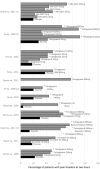Blocking CGRP in migraine patients - a review of pros and cons
- PMID: 28948500
- PMCID: PMC5612904
- DOI: 10.1186/s10194-017-0807-1
Blocking CGRP in migraine patients - a review of pros and cons
Abstract
Migraine is the most prevalent neurological disorder worldwide and it has immense socioeconomic impact. Currently, preventative treatment options for migraine include drugs developed for diseases other than migraine such as hypertension, depression and epilepsy. During the last decade, however, blocking calcitonin gene-related peptide (CGRP) has emerged as a possible mechanism for prevention of migraine attacks. CGRP has been shown to be released during migraine attacks and it may play a causative role in induction of migraine attacks. Here, we review the pros and cons of blocking CGRP in migraine patients. To date, two different classes of drugs blocking CGRP have been developed: small molecule CGRP receptor antagonists (gepants), and monoclonal antibodies, targeting either CGRP or the CGRP receptor. Several trials have been conducted to test the efficacy and safety of these drugs. In general, a superior efficacy compared to placebo has been shown, especially with regards to the antibodies. In addition, the efficacy is in line with other currently used prophylactic treatments. The drugs have also been well tolerated, except for some of the gepants, which induced a transient increase in transaminases. Thus, blocking CGRP in migraine patients is seemingly both efficient and well tolerated. However, CGRP and its receptor are abundantly present in both the vasculature, and in the peripheral and central nervous system, and are involved in several physiological processes. Therefore, blocking CGRP may pose a risk in subjects with comorbidities such as cardiovascular diseases. In addition, long-term effects are still unknown. Evidence from animal studies suggests that blocking CGRP may induce constipation, affect the homeostatic functions of the pituitary hormones or attenuate wound healing. However, these effects have so far not been reported in human studies. In conclusion, this review suggests that, based on current knowledge, the pros of blocking CGRP in migraine patients exceeds the cons.
Keywords: Acute treatment; Cgrp; Cgrp receptor; Gepants; Migraine; Prophylactic treatment.
Conflict of interest statement
Ethics approval and consent to participate
Not applicable
Consent for publication
Not applicable
Competing interests
AMvdB received research grants from Amgen/Novartis. LE has given talks and received grant for preclinical studies sponsored by Novartis and TEVA.
All other authors declare no conflicts of interest.
Publisher’s Note
Springer Nature remains neutral with regard to jurisdictional claims in published maps and institutional affiliations.
Figures



References
-
- Edvinsson L. Functional role of perivascular peptides in the control of cerebral circulation. Trends Neurosci. 1985;2:2–7.
Publication types
MeSH terms
Substances
LinkOut - more resources
Full Text Sources
Other Literature Sources
Medical
Research Materials
Miscellaneous

